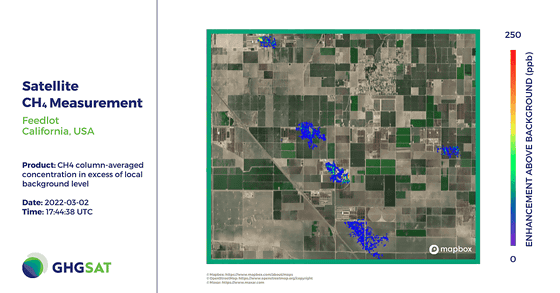'Cow burps' are clearly visible from space

GHGSat, a Canadian environmental data company, announced that it had been able to confirm methane gas emissions from cows burping on a farm using a high-resolution satellite orbiting at an altitude of 500 km. This is a rare example of the previously pointed out 'greenhouse gas emissions from livestock' being confirmed from space.
Cow burps seen from space - GHGSat
Planet-warming emissions from cow burps have been seen from space - CNN
https://edition.cnn.com/2022/04/30/us/cow-burps-methane-space-climate-trnd/index.html
GHGSat has been conducting a project to monitor methane gas emissions from satellites since around 2016, and as of May 2022, five satellites are orbiting in sun-synchronous orbit at an altitude of about 500 km. GHGSat's satellites are about the size of a microwave oven and are equipped with highly accurate sensors that can even detect methane gas leaks from facilities.
Private companies are starting to monitor methane gas emissions, which cause global warming, from satellites - GIGAZINE

On March 2, 2022, the GHGSat satellite confirmed methane emissions in agricultural areas of California's San Joaquin Valley, with emissions ranging from 361 to 668 kg per hour, which equates to roughly 5,116 tons per year.
The actual results of observation from the satellite are below. The colored dots on the satellite image of the farm indicate methane gas emissions, and the green and yellow areas are the points with the highest emissions.

The larger-scale image on the right shows that methane emissions are concentrated in certain areas of the farm, with particularly high levels around the facility at one end of the farm.

GHGSat's survey revealed that the methane emissions were located at cattle feedlots, meaning that it was possible to see from space that huge amounts of methane were being emitted from cattle.
Livestock burps are one of the largest sources of methane, a greenhouse gas. Livestock production is a major industry in California, and the state's 1.4 million cows are one of the largest sources of methane gas in the country, and legislation is underway. Various methods are being tested to reduce methane emissions from cows, such as adding small amounts of seaweed to their feed, but accurate measurement of methane emissions from cow burps is necessary before the livestock industry can set targets and adopt new practices.
Brody Wight, sales director at GHGSat, commented, 'This is the first time we've been able to measure methane emissions from livestock using satellite imagery.' According to Wight, the satellite flies over a designated location for 20 seconds and can create a snapshot that shows changes in emissions over time. By combining cattle methane emissions with feeding programs, it is expected that livestock farmers will be able to support their efforts to reduce methane emissions from cattle burps.
Related Posts:
in Free Member, Science, Creature, Posted by log1i_yk






